Missing Argentine submarine 'running out of air' and had reported fault before vanishing

An Argentine submarine missing in the South Atlantic is likely to be running out of air and had reported technical problems before vanishing, naval officials have said.
ARA San Juan’s last message reported a short circuit in its batteries and the vessel was ordered to return to its home.
The Argentine navy quashed hopes that a series of brief incomplete satellite calls detected over the weekend could have been emergency calls from the vessel and disclosed it may only have a couple of days oxygen left.
Buenos Aires was also beginning to face domestic criticism of its handling of the search, with one union describing government efforts as badly coordinated and apathetic.

The submarine and its crew of 44 have now been missing for five days as a growing fleet of international vessels and patrol planes brave 20ft waves and high winds to search hundreds of square miles.
US Navy submarine rescue chambers have been flown to the region in the hope of bringing the crew to the surface in case the vessel can be found.
Gabriel Galeazzi, a spokesman for the Argentine Navy, said the German-built diesel electric vessel had surfaced on Wednesday to report the fault.
He said: “At that moment the commander was ordered to go directly to Mar de Plata. After that we lost contact.”

He suggested the fault could have affected the submarine’s navigation, but said it did have back-up systems.
Although the crew has enough food, oxygen and fuel to survive about 90 days on the sea's surface, they only have enough oxygen to last for seven days if submerged. After that, the boat would have to surface or get near the surface to replenish air supply.
Seven brief satellite signals lasting only seconds were detected over the weekend, raising hopes the crew were trying to call and prompting jubilation among the waiting families.

But analysis of the low frequency signals later found they were not from the submarine.
Up to 20 vessels, including the Royal Navy’s HMS Protector and HMS Clyde are joining the search. Britain has also sent an RAF C-130 aircraft and a Voyager refuelling aircraft to help it search for longer.
Cdr Erik Reynolds, spokesman for the US Navy, which is coordinating the international effort, said vessels were using their sonar to hunt for the ship, though high waves are hampering efforts. Maritime patrol planes are searching for signs of oil or waste that could have been jettisoned by the crew to signal their location.

Two US Navy undersea submarine rescue vessels are on standby if needed for a rescue. The vessels can attach to the hatch of a stricken submarine at depths of up to 2,000ft and then ferry surviving crew back to the surface.
"There is no good news," Juan Carlos Mendoza, father of crew member Fernando Mendoza, told local reporters. "Hopefully they have oxygen."
The ARA San Juan was inaugurated in 1983, making it the newest of the three submarines in the navy's fleet. Built in Germany, it underwent maintenance in 2008 in Argentina.
That maintenance included the replacement of its four diesel engines and its electric propeller engines, according to specialist publication Jane's Sentinel.
ATEPSA, a union representing workers in the protection and security of aeronautics, said the case of the submarine "puts centre stage the recurring failures in state policies". It said in a statement that "the apathy in the Services of Search and Rescue, and the lack of coordination which exists in all the public bodies involved, are the faithful reflection of multiple errors which complicate the principle objective: to reach the victims in an urgent manner".
The union noted workers in several airports were participating in search operations "despite the problems of communication in the oceanic sector due to lack of investment." This was "aggravated by the fact that the plant that transmits and receives all the aeronautic communications in the country does not have staff," it complained.

 Yahoo News
Yahoo News 
